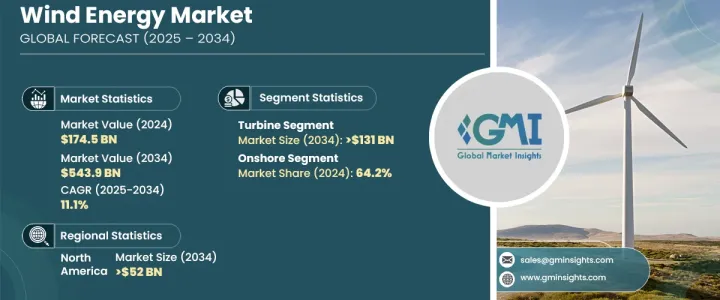
세계 풍력에너지 시장은 2024년 1,745억 달러로 평가되었고, 2025-2034년 연평균 11.1%의 성장률을 보일 것으로 예측됩니다.
성장의 주요 요인은 아시아, 유럽, 북미의 대규모 개발 및 해상 풍력 발전 프로젝트에 대한 투자 증가입니다. 재생 가능 에너지에 대한 수요가 급증하는 가운데, 풍력 발전은 현재 전 세계 전력 공급의 10% 이상에 기여하고 있습니다. 비용 효율적이고 대용량 터빈과 첨단 에너지 생산 설계에 대한 신뢰가 높아지면서 시장 침투가 가속화되고 있습니다. 재료, 공기역학, 디지털화 분야의 끊임없는 혁신은 터빈 효율을 향상시키고, 성능 향상과 채택 확대로 이어지고 있습니다.

여러 국가들이 청정 에너지로의 전환을 추진하고 있으며, 중국, 브라질, 호주에서 풍력에너지 도입이 확대되고 있습니다. 각국 정부는 풍력 발전소 개발에 대한 야심찬 목표를 설정하고 있으며, 시장 성장을 강화하는 규제적 인센티브가 뒷받침되고 있습니다. 센서, 데이터 분석, 머신러닝과 같은 첨단 기술의 통합으로 유지보수 및 터빈 효율의 최적화가 진행되고 있습니다. 풍력 및 기타 재생에너지에 주력하는 독립 발전 사업자들은 특히 신흥 시장에서 이러한 기술 혁신을 활용하여 포트폴리오를 확장하고 있습니다.
| 시장 범위 | |
|---|---|
| 시작 연도 | 2024년 |
| 예측 연도 | 2025-2034년 |
| 시작 금액 | 1,745억 달러 |
| 예상 금액 | 5,439억 달러 |
| CAGR | 11.1% |
풍력에너지 시장은 구성 요소에 따라 터빈, 지지 구조물, 전기 인프라, 기타로 구분됩니다. 터빈 분야는 업계가 더 큰 용량의 대형 터빈으로 전환함에 따라 2034년까지 1,310억 달러 이상에 달할 것으로 예상됩니다. 첨단 부유식 플랫폼은 해상 터빈의 고정 문제를 해결하고 해저 구조물에 의존하지 않고 심해에 배치할 수 있도록 해줍니다. 향상된 내구성과 성능 중심의 설계는 주요 지역에서 터빈의 채택을 더욱 강화하고 있습니다.
설치 유형별로 보면, 시장은 육상과 해상으로 나뉘며, 2024년 육상 풍력 발전이 64.2%의 점유율을 차지할 것으로 예상됩니다. 경제 성장, 에너지 안보에 대한 우려, 이산화탄소 배출량 감축 목표가 육상 풍력 발전의 채택을 촉진하고 있습니다. 최신 로터 구성은 블레이드의 위치를 개선하고 에너지 출력을 크게 향상시켰습니다. 새로운 소재와 최첨단 블레이드 설계는 유지보수의 필요성을 줄이면서 효율을 높여 육상 풍력에너지를 널리 선호되는 솔루션으로 만들고 있습니다.
미국 풍력에너지 시장은 2022년 117억 달러, 2023년 86억 달러, 2024년 172억 달러의 매출을 기록할 것으로 예상됩니다. 북미 풍력에너지 부문은 2034년까지 연평균 520억 달러 이상의 성장률을 나타낼 것으로 예상됩니다. 시장 확대는 정책적 지원, 기술 혁신, 진화하는 산업 역학에 의해 촉진될 것입니다. 그리드 통합과 에너지 저장 솔루션의 발전은 풍력 발전의 안정성과 신뢰성을 향상시켜 지역 전체에서 풍력 발전의 채택을 더욱 촉진하고 있습니다.
The Global Wind Energy Market was valued at USD 174.5 billion in 2024 and is projected to expand at a CAGR of 11.1% between 2025 and 2034. Growth is primarily fueled by significant developments in Asia, Europe, and North America, alongside rising investments in offshore wind projects. As the demand for renewable energy surges, wind power now contributes over 10% of the global electricity supply. Increasing reliance on cost-efficient, high-capacity turbines and advanced energy-producing designs is accelerating market penetration. Continuous innovations in materials, aerodynamics, and digitalization are improving turbine efficiency, leading to enhanced performance and greater adoption.

With several countries transitioning toward cleaner energy, wind energy deployment is expanding across China, Brazil, and Australia. Governments worldwide are setting ambitious targets for wind farm development, supported by regulatory incentives that strengthen market growth. The integration of advanced technologies, including sensors, data analytics, and machine learning, is optimizing maintenance and turbine efficiency. Independent Power Producers focusing on wind and other renewables are leveraging these innovations to expand their portfolios, particularly in emerging markets.
| Market Scope | |
|---|---|
| Start Year | 2024 |
| Forecast Year | 2025-2034 |
| Start Value | $174.5 Billion |
| Forecast Value | $543.9 Billion |
| CAGR | 11.1% |
The wind energy market is segmented based on components into turbines, support structures, electrical infrastructure, and others. The turbine segment is set to surpass USD 131 billion by 2034 as the industry shifts toward larger, high-capacity turbines. Advanced floating platforms are resolving offshore turbine anchoring challenges, enabling deployment in deeper waters without relying on seabed structures. Enhanced durability and performance-driven designs are further reinforcing turbine adoption across key regions.
By installation type, the market is divided into onshore and offshore segments, with onshore wind energy holding a 64.2% share in 2024. Economic expansion, energy security concerns, and carbon emission reduction goals are driving onshore wind adoption. Modern rotor configurations are improving blade positioning, significantly increasing energy output. New materials and cutting-edge blade designs are enhancing efficiency while reducing maintenance requirements, making onshore wind energy a widely preferred solution.
In the United States, the wind energy market generated USD 11.7 billion in 2022, USD 8.6 billion in 2023, and USD 17.2 billion in 2024. The North American wind energy sector is expected to grow at a compound annual growth rate exceeding USD 52 billion by 2034. Market expansion is propelled by policy support, technological innovations, and evolving industry dynamics. Advancements in grid integration and energy storage solutions are enhancing wind power stability and reliability, further driving adoption across the region.